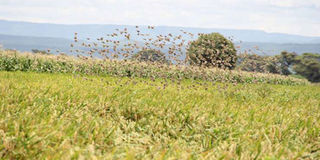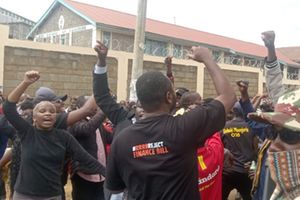Severe drought force Thais to abandon rice farming

Birds invade a rice farm at Perkerra Irrigation Scheme in Baringo County on April 19, 2013. Drought is forcing Thailand rice farmers to opt for other crops. PHOTO | JARED NYATAYA | NATION MEDIA GROUP
What you need to know:
- Four consecutive years of below-average rainfall have drained water reserves and strangled production, pushing many farmers into debt.
- The current drought, the worst the country has seen in decades, has hit nearly a third of Thailand’s 76 provinces, particularly in the rice-heavy central and northeast.
- The ruling military junta asked farmers to abandon their winter rice crop, which is normally cultivated through irrigation and not rainfall.
NONTHABURI, Thailand, Sunday
Thailand has long served as one of the globe’s main rice bowls, but chronic water shortages are pushing the country to move away from a grain that dominates its fields and has defined a way of life for generations.
Laddawan Kamsong has spent the past 40 years coaxing rice from her plot in central Thailand, but she is tired of watching her farmland squeezed dry by increasingly severe droughts.
“I plan to replace some rice paddies with limes,” she told AFP after attending a government-run workshop urging farmers to diversify their crops.
Thailand is one of the world’s top rice exporters.
But four consecutive years of below-average rainfall have drained water reserves and strangled production, pushing many farmers into debt.
The current drought, the worst the country has seen in decades, has hit nearly a third of Thailand’s 76 provinces, particularly in the rice-heavy central and northeast. Reservoirs are also dropping to historically low levels. The kingdom’s military government is now organising training sessions to encourage millions of rice farmers to diversify into crops that require less irrigation.
CULTIVATING FRUIT TREES
Unlike nearly all other crops, rice grows best in a flooded field, with the stalk’s base completely submerged for most of the growing season.
At an army-run workshop held in patch of shade in a field in Nonthaburi province near Bangkok, Laddawan was sold the merits of cultivating fruit trees. In other regions, they are suggesting sugarcane or peas.
These alternatives will drastically reduce water consumption but also break the monoculture that has deteriorated Thai soil for decades.
“We have no choice, we need to adapt,” Laddawan said, explaining that she used to plant three rice crops annually, but next year will only have enough water for one.
As the drought bites, some 2,000 Thai villages are surviving off water delivered by the government, while ‘rainmaking’ airplanes are flying over parched plains, sending an iodine solution into the air in an effort to seed clouds.
After last year’s especially weak rainy season — which falls between June and October — the ruling military junta asked farmers to abandon their winter rice crop, which is normally cultivated through irrigation and not rainfall.
“The amount of water in storage is low and now we expect that this year’s rainy season will be delayed because of El Nino,” said Suphot Tovichakchaikul, who leads the country’s water management department.
The El Nino weather phenomenon tends to weaken the annual monsoon, which is a lifeline to farmers across the region.
According to a study from the University of the Chamber of Commerce, the drought could shave between 0.5 and 0.8 per cent off Thailand’s GDP growth, with its annual rice production predicted to drop almost 30 per cent to 25 million tonnes.





